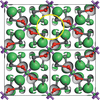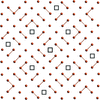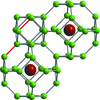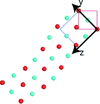issue contents
December 2020 issue

Cover illustration: Polyhedral representation of the structure of γ1-AuZn2.1 along [001], see Koley et al. [(2020). Acta Cryst. B76, 1109–1116].
research papers
Download citation


Download citation


Crystal structures of two polymorphic forms of dibenzoylmethane have been investigated via quantum chemistry and quantum crystallography methods to describe and explain a particular position of hydroxyl hydrogen atom in malondialdehyde quasi-ring of the chalcone.
Download citation


Download citation


A new cocrystal of L-ascorbic and picolinic acids is reported. The relationship between the conformation of the L-ascorbic acid molecule and its effective charge in the new cocrystal, as well as in pure ascorbic acid and 12 previously documented L-ascorbic acid cocrystals, is discussed.
Download citation


Download citation


Open  access
access
 access
accessThe structure of Pb2SnO4 is found to strongly distort on compression and a structural phase transition with a change of space group from Pbam to Pnam occurs at ∼11 GPa. Our complementary DFT-based calculations show that at ambient conditions, the channels in the structure host the stereochemically active Pb 6s2 lone electron pairs which form bonds between the Pb2+ ions with increasing pressure.
Download citation


Download citation


The first bismuth borate oxyiodide, Bi4BO7I, is incommensurately modulated with q = 0.242 (3)c*. The wavevector is very close to the rational value of c*/4, yet refinement based on commensurate modulation faces serious problems indicating the incommensurate nature of the modulation.
B-IncStrDB reference: 16542EibJgm
CCDC reference: 2032387
Download citation


Download citation


Seven new metal–organic frameworks (MOFs) assembled from 3-(3,5-dicarboxylphenoxy)phthalic acid (H4L1) and 4-(3,5-dicarboxylphenoxy)phthalic acid (H4L2) have been synthesized under similar conditions with transition-metal ions in the presence of auxiliary N-donor ligands. The various structures of the MOFs have been generated by adjusting the N-donor auxiliary ligands and the central metal ions. Their syntheses, 3D supramolecular structures, topological structures, structural comparison, fluorescence and magnetic properties are discussed in detail.
Download citation


Download citation


Experimental charge density distribution of abiraterone acetate is reported. Intermolecular interactions in the crystals of abiraterone, abiraterone acetate and abiraterone complexes with cytochrome P450 binding pocket are compared.
CCDC reference: 2035079
Download citation


Download citation


Open  access
access
 access
accessMultiple-Edge Anomalous Diffraction (MEAD) has been applied to various quaternary sulfosalts belonging to the adamantine compound family in order to validate the distribution of copper, zinc and iron cations in the structure. Application of this technique confirms established cation distribution in Cu2ZnSnSe4 (CZTSe) and Cu2FeSnS4 (CFTS), but in Cu2ZnSiSe4 (CZSiSe) the cation distribution is shown to adopt a highly ordered wurtz-kesterite structure type in contrast to the literature.
Download citation


Download citation


A new olanzapine–phenol cocrystal was discovered as an intermediate product during the crystallization of olanzapine from volatile deep eutectic solvents. The ability of 3D ED to investigate nanocrystalline intermediate forms paves the way for a thorough understanding of the crystallization pathways in pharmaceutical chemistry.
It is demonstrated that the flatness parameter of layers, the Madelung constant and the bonding angle I—M—I are strictly correlated and increase in the same order: FeI2 < PbI2 < MnI2 < CdI2 < MgI2 < CaI2. With the increase of the Madelung constant and bonding angle I—M—I the relative contribution of the Coulomb energy to cohesive energy increases, whereas the relative contribution of the covalent energy decreases.
Download citation


Download citation


Open  access
access
 access
accessThe ability of perovskite-type oxide materials to exsolve nanoparticles can be controlled by changing their elemental composition. This enables the precise and controlled preparation of catalyst materials with nanoparticles decorating the surfaces.
Ferroelectric LiNb1–xTaxO3 crystals with various compositions were grown from the melt by the Czochralski method. The compositions, crystal unit-cell parameters and physical properties of the grown crystals including Curie temperature and velocity of surface acoustic waves were studied.
Download citation


Download citation


A combination of resources – FT–IR, X-ray diffraction, PES, RMSD, Hirshfeld surface analysis and the Quantum Theory of Atoms in Molecules (QTAIM), and electron localization theories implemented in QTAIM, ELF and NCI – were used to study two conformational polymorphs of 4-methylhippuric acid obtained by solvent evaporation and mechanical grinding.
Download citation


Download citation


Open  access
access
 access
accessThe incommensurately modulated crystal structures of RETe1.94 (1) (RE = La, Pr, Nd) feature Te vacancies and different polytelluride fragments in planar chalcogenide layers.
B-IncStrDB reference: 16592EwKlsV
Download citation


Download citation


High-quality Fe1–xGaxBO3 single crystals with 0 ≤ x ≤ 1 were flux-grown and studied using energy-dispersive X-ray spectroscopy, X-ray diffraction and Mössbauer spectroscopy.
Download citation


Download citation


The synthesis, crystal structure and stability of the γ-brass-related complex phase γ1-AuZn2.1 in the Au–Zn binary system are reported. The compound has been described as consisting of two main building units, i.e. a 38-atom modified Pierce cluster and an intergrown 19-atom double icosahedron.
CCDC reference: 1997815
Download citation


Download citation


The correlation between the characteristic changes in the structural parameters and physical properties of Kondo insulator YbB12 in the temperature range of the metal–insulator transition has been studied for the first time.
Download citation


Download citation


Determination of an orthorhombic crystal structure in a solid phase of smectogenic compound 7OS5 (4-n-pentylphenyl-4′-n-heptyloxythiobenzoate) is reported. Polymorphism in the solid and liquid crystalline phases is investigated by complementary methods.
CCDC reference: 1960049
Download citation


Download citation


Open  access
access
 access
accessTwo high-nitrogen-content azido-triazolo pyridazines (C5H3N7 and C6H5N7) crystallize either as anhydrate or hydrated clathrate. High pressure changes the water content in the clathrate. Intermolecular contacts N⋯N are formed between the azide group only.
addenda and errata
Open  access
access
 access
accessCorrections are made to certain entries in Table 3 of the paper by Carpenter & Howard [(2018), Acta Cryst. B74, 560–573].
book reviews
Free 


 journal menu
journal menu













































